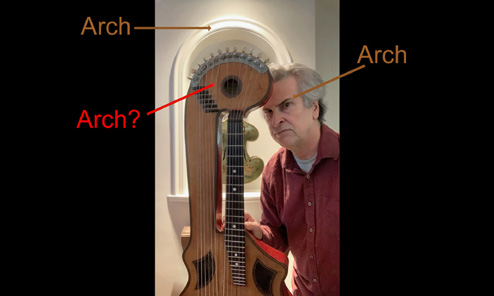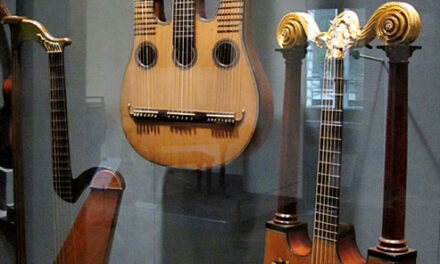
(The reason for my arched eyebrow will become clear soon enough…)
Bogen, shmogen!
Yes, I’ve revised my stance re the “nomenclature” for the newest Miner Museum treasure: a 1908 Karl Müller (Augsburg) copy of a Friedrich Schenk “bogengitarre.”

Schenk’s original c.1850 instrument is a stunning and indescribable design that many German luthiers revisited some decades later, usually putting their own spin on it.
Müller’s second label inside the upper soundbox appears to denote that his is an “exact copy” of a specific Schenk specimen he had in hand at the time. Indeed, it seems to match a Schenk design (he had many variations) precisely.

Schenk typically included three sub-basses, rarely four, for the needs of soloists; this one has six, which is ideal for modern harp guitarists like myself.
Schenk and others also built these in all sizes and scale-lengths, some tuned to terz (a minor third higher). This one is standard with a shortish scale of 608mm (a bit under 24”), and the instrument itself is fairly small – just 16” wide and 37.5” in total length. Yet it sounds like a much larger instrument, with perfect balance from the lowest bass all the way up to the first string’s 24th fret (yes, 24!).


This specimen actually appeared on my site some years ago, then possibly changed hands once or twice, finally ending up at a stained glass window company in Germany, its custodians happy to send it next to Los Angeles in its original case within a wooden crate. The last thing we know is that 18 years ago guitar builder Urs Langenbacher did some minor restoration on it for the anonymous owner and supplied new custom Pyramid strings (still on it and sound fine). Urs chose A-to-D chromatic tuning for the subs (six-bass tuning for these instruments does not appear to have ever been written in stone, if written at all).

So…“bogen”…what, why, when? For those unfamiliar with my 2011 post on “Bent Guitars,” that was my tongue-in-cheek definition for this untranslatable term (well, it can be translated, we just don’t know into what). “Bow,” “Arch,” “Bend”? Or would it be more accurately “Bowed,” “Arched” or “Bent”? That’s a big difference right there. What we know it is not is “bowed” meaning “played with a bow”…which, incidentally, is the only meaning with provenance – but for a completely different instrument (the “Arpeggione” and other fretted guitars played with a bow).
So, when I acquired this, I asked my German & Austrian colleagues/experts Erik Hofmann and Stefan Hackl if they would “go on record.” Both agreed that “bogengitarre” is a later (post-1900s?) vernacular term concocted by persons unknown. There seems to be no provenance or evidence for where and when (and why) the term appeared…and no one knows what Schenk himself called his original models. Similarly, there’s no record yet discovered of how Schenk referred to his earlier double-armed harp guitar, referred to (more logically) as a lyragitarre in the 1900s. (That’s one of them held by Dick Boak in the Martin Museum below.) It might be interesting, and also now useful, to compare the arms and heads of these two key Schenk designs.

Stefan believes that bogen likely referred to the arm – but how exactly is it bowed or arched? Or are we referring just to the sudden curve into the oval head? Emanating from the already-unusual wappen-shaped body, the arm is virtually straight (unlike the very curved arms of our Dyers and Knutsens). It almost seems to serve merely as connecting real estate to the real purpose of the design; the elaborate, additional hollow head. The latter is a remarkable and practical, if bizarre-looking element that provides close audience members with a delightful subtle stereo effect. It seems a natural outgrowth of the same “head soundbox” of Schenk’s lyragitarre, where it more organically forms a bridge between the symmetrical arms.
Now note my illustration. Erik wonders if “arch” may have actually been the intended meaning (as in the window archway shown) – corresponding to the rather feeble “arch” visual imagined in the top half of the head section when the instrument stands upright. I’d agree that this seems as likely as any of the poor choices given us – but then, that would bring yet another (iffy) “arch-guitar” definition into that study! (Readers may recall that I defined the modern archguitar at HGG12 in Idaho and later revised it for my 2019 AMIS paper – where I famously introduced – and gave legitimacy once and for all to – the scholarly term “badass.”)
My vote? Until someone finds a smoking gun historical explanation (that also has some logical basis), there will be no “bow” nor “arch” for me. That means we still need a term for these particular Schenk harp guitars and their progeny…as both Erik and I think “bogen” is, well…bogus.

PS: Lest you think this instrument was not taken seriously, you should read Heinrich Albert and the World’s First Harp Guitar Quartet.

.Oh, and as an extra bogus bogen bonus, the case candy included a single unused original Karl Müller brand sub-bass string!







The extra bogus bogen bonus is amazing. Congratulations, and a very in-depth article. Has it been to the Miner lab of antique guitar string material analysis?